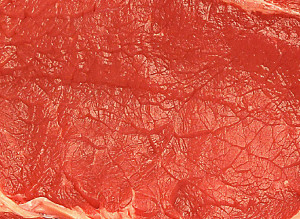Could Eating a Low Fat Diet Make You Fat and Sick?
Low fat & low calorie diets aren’t just something that weight loss experts recommend. The Center for Disease Control even recommends that in order to stay healthy and lean you should eat a low fat, low calorie diet.
I am going to show you how eating a diet that is low in fat and calories could be making you fat, sick and frustrated!
Fat free foods, or low calorie foods are so easy to find at any grocery store these days. For just about every full-fat version of a food, there is likely to be a reduced version of the same food. And it is no secret that eating a diet lower in calories and fat is the key to weight loss, so why are obesity rates at an all-time high?
Let’s take a look at a pretty typical day of eating a low fat, low calorie diet. For this example you would be eating three meals per day and of course a low calorie snack for dessert, because everyone deserves a treat now and then, right? Since losing weight is the goal, I want to make sure this diet is fairly low in calories, so let’s aim for about 1,500 calories per day.
The meals that I found are random and were found by simply searching the internet for low fat or low calorie food options. These items would be present in any grocery store in the country and would generally be considered to be healthy by many shoppers.
Breakfast: (Calories/Grams of fat)
1 cup Special K Cereal – 120 calories and 0.5 grams of fat
1 cup skim milk – 86 calories and 0.4 grams of fat
Starbucks 12oz cafe latte with skim milk = 126 calories and 0 grams of fat
Lunch:
Lean Pockets Ham and Cheddar – 280 calories and 7 grams of fat
Baked Lays BBQ potato chips – 123 calories and 3.1 grams of fat
Dinner:
Lean Cuisine Alfredo Pasta with Chicken and Broccoli – 270 calories and 4 grams of fat
Dessert:
Chips Ahoy 100 Calorie Thin Crisps – 100 calories and 3 grams of fat
I think this is a pretty light day of eating, but if you really had some willpower this would be totally doable. You have your three meals for the day, your protein, a coffee treat and even a snack! So let’s count up those calories and grams of fat and see where we are at.
Total Calories = 1105
Total Fat = 18 grams
This is pretty great news, right? Not only will this diet give you less than 20 grams of fat in a day, but your total calorie count is well below the 1,500 mark. At this rate, you could safely eat another 400 calories of food, but let’s not get ahead of ourselves just yet.
The reason that this diet is going to fail and make you fat and sick is very simply because when you concentrate only on low fat, low calorie foods, you miss a really important part of the bigger picture. There is an ingredient that is added to more of your food than you may be aware of, and it is hiding in plain sight under the disguise of lower calories and healthy foods. And that ingredient is sugar. More specifically, high fructose corn syrup. High fructose corn syrup was introduced in the mid 1970’s as a cheap alternative sweetener that could easily be added to soft drinks. You may have heard that HFCS is a safe product because it is natural, and comes from corn.
While it is true that HFCS is made from corn, it should not be considered safe to consume in any quantity, let alone the quantities that many Americans and people from around the world are consuming it. The truth is, the human body could survive without HFCS without a single negative effect whatsoever.
According to the Center for Disease Control (CDC) obesity rates in this country doubled between 1980 and 2000, to about 60 million adults.[1] While correlation does not equal causation, it is certainly something to think about when you consider this happened just a few years after high fructose corn syrup started being added to a large portion of our soft drinks and processed foods.
And since it is cheaper to add to food than traditional granulated sugar, it is safe to assume that you will be quite likely to find it in a lot of your food that you buy in the grocery store. Low fat, and low calorie foods are no exception to this.
So how much sugar, or high fructose corn syrup is in all of this wonderful low fat, low calorie food that you just ate for your recommended diet?
54 Grams which is about equal to 13.5 teaspoons!
The World Health Organization recommends that a person with a normal body mass index (BMI) consume no more than 25 grams of sugar per day, which is about 6 teaspoons. [2] So right from the start, when you eat a diet similar to this example, which is low in calories and fat, you are consuming twice the recommended daily allowance of sugar.
But that’s not all. Researchers at Princeton have found that high fructose corn syrup is actually worse for your health than regular sugar. In the study, researchers gave two groups of rats the same amounts of “rat chow”, but changed up their beverage a little bit.
One group got ordinary table sugar in a water solution, and the other group had access to high fructose corn syrup. What they saw was that the rats who consumed the high fructose corn syrup gained significantly more weight than their regular sugar-water rat counterparts [3].
But that’s not all. The researchers also found that the high fructose corn syrup rats had abnormal increases in fat in their abdomen, as well as a rise in their triglycerides. In other words, they were becoming fat and sick. And if that’s not all, they also noted that another group of rats who were given the HFCS over a period of six months began to show signs of metabolic syndrome in comparison to rats who only were given the rat chow.
It is estimated that about 20 to 25 percent of adult Americans suffer from metabolic syndrome. Below are some metabolic risk factors. While it is possible to have any number of these alone, you are considered at risk for metabolic syndrome if you have three of the following conditions:[4]
- Abdominal obesity, or having an “apple” shape
- High triglyceride levels
- Low HDL (good) cholesterol levels
- High blood pressure
- High fasting blood sugar
Is high fructose corn syrup the smoking gun in the fight against obesity? The research is not in just yet on that, but researchers are tirelessly working on it. Do you think there may be enough data to show that it is a major contributor to obesity and a wide array of diseases that are costing our society billions of dollars to treat?
This is for you to decide, but you must also decide if it is worth the risk of taking the chance.
If you have ever wondered if weight loss and better health can really be easy, maybe it would be worth it to try a diet that is a way of life, and not the newest fad. Counting calories and grams of fat may mean you eat foods with low amounts of both calories and fat, but if there is even a small chance that you could be at risk for metabolic syndrome and the conditions that come with it, perhaps it is not the best answer.
 Most of the fat eaten in the modern diet is partially hydrogenated fats or saturated fats. Our diet is also too high in omega 6 fatty acids. While we need to eliminate trans fats altogether, a proper balance of the other fatty acids is one of the foundations of a healthy, balanced diet.
Most of the fat eaten in the modern diet is partially hydrogenated fats or saturated fats. Our diet is also too high in omega 6 fatty acids. While we need to eliminate trans fats altogether, a proper balance of the other fatty acids is one of the foundations of a healthy, balanced diet. And yet, saturated fats are as essential to our health as unsaturated fats. Raymond Francis says, “Saturated fat is what gives the cell membrane backbone. It gives stiffness to the cell membrane. Obviously, this is necessary, but when you get too much saturated fat in the diet, the cell membrane is too stiff. Consequently the tissue made out of these cells is too stiff. Then you have people pulling muscles, and tendons, because their tissues are not elastic enough, they are too stiff.”
And yet, saturated fats are as essential to our health as unsaturated fats. Raymond Francis says, “Saturated fat is what gives the cell membrane backbone. It gives stiffness to the cell membrane. Obviously, this is necessary, but when you get too much saturated fat in the diet, the cell membrane is too stiff. Consequently the tissue made out of these cells is too stiff. Then you have people pulling muscles, and tendons, because their tissues are not elastic enough, they are too stiff.”